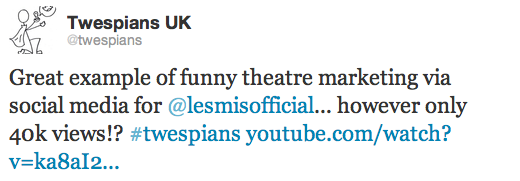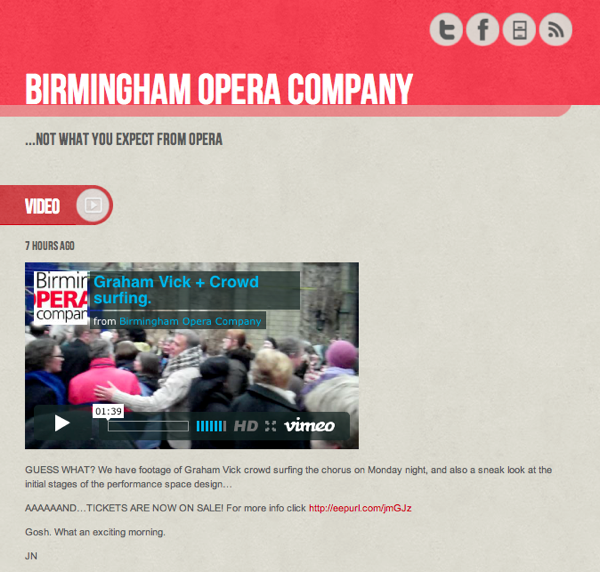This post is a follow-up to my previous one and is about using data from social media to improve decision-making in marketing. Don’t say you weren’t warned.
First up, an example (with apologies to anyone who feels like I’m picking on them).
A poor assumption
I’d not come across The Les Mis Contract before – it’s a comedy skit featuring Matt Lucas, Cameron Mackintosh and Alfie Boe and is the 7th most popular of the 62 videos on the official Les Miserables YouTube account. At the Twespians event on Friday it was held up as an example of a more interesting approach to online theatre marketing. So far, so fair enough.
Someone in the audience asked how many views it had racked up – the answer at the time of typing being 38,874 over 11 months. The general muttered reaction in the room was ‘that’s not very good’, as reflected in this tweet:

Presumably the thinking went like this – 40k people is barely enough to fill a West End theatre for a fortnight and you can bet not everyone who saw the video bought a ticket. Also, 40k views is nothing compared to what some videos on YouTube get. #FAIL.
The thing is, we need to know so much more before deciding whether or not that video worked. For instance:
- How much did the video cost to produce?
- How many people rang the box office number, entered the URL from the video or clicked the URL in the video’s description? (Assuming these things were being tracked properly).
- How many tickets did each of those people book and at what price?
- How many of the website visitors or tickets buyers were new ones?
- Once a person has bought tickets and handed over their contact details, what’s that person’s lifetime value likely to be?
- Was there any increase in organic search traffic around related keywords – for example, those that included ‘Matt Lucas’?
- Did the video create any additional PR value? Did it lead to Les Mis being mentioned at more events and on more blogs?
And so on… you see what I’m getting at? The number of views tells us nothing. Just to hammer the point home:
- If that video cost £1,500, took a couple of days to pull together, drove £10,000 of sales, added new contact details to the company’s email lists and was featured on a few theatre blogs then I’d call it a success.
- If it cost £10,000, tied up resources for a fortnight and drove £1,500 of sales, with all but one customer already being on the company’s mailing list then I’d be chalking it up to experience.
The point is…
Far too many reports, articles and discussions about the effectiveness of social media marketing (especially in the arts and culture sector) are hampered by assumptions based on poor information. Just because some stats (followers, fans, subscribers, views, etc) are publicly available doesn’t mean they tell us anything conclusive.
I think all of this is caused by two things. The first is that although good, actionable data is there to be collected and analysed, it’s rarely made available to third parties (and nor would I expect it to be). However, people seem to enjoy talking about social media and so the vacuum is filled by people’s reckoning instead.
Secondly, I think there’s a big skills gap here and the landscape it constantly evolving. Web analytics aren’t part of the standard marketing syllabus and most arts organisations don’t have the resources to employ a specialist web analyst. The few that are out there aren’t especially vocal. As a result, most others don’t know what they’re missing out on and there’s nobody to pick up on any mistakes.
On that note, a couple of corrections…
There were a couple of things in Sven’s thesis that I’d like to bring up. It’ll be my last word on it, I swear, but I think it illustrates my point.
In the Recommendations section (on p40) there’s a SWOT analysis. The following are listed under ‘Weaknesses’:
6. Few people indicate social media marketing has influenced their buying decision. Then again, this is impossible to measure, just as it is impossible to determine which outdoor billboard influenced a persons buying decision
It’s not impossible to measure! That’s what Google Analytics, ecommerce tracking and a sensible approach to campaign URLs were all invented for. We’re not even limited to last click attribution – there’s fun to be had with the rest of the sales cycle too.
7. Measurement is available, but it usually comes at a high price. Even the most sophisticated measurement tools are not able to link a specific ticket sale to a message one posted on social networks. Twitter and Facebook do not allow tracking of that data
Wrong on the first two counts (but right on the last point). Google Analytics is a free service, awe.sm won’t exactly break the bank (although I’ve yet to have a proper play with it) and I’m sure there are other options out there too. Maybe the costly bit is in hiring a full-time analyst or getting someone like me in to do some training (and I’m a bargain, really). Meanwhile, see above regarding social media attribution.
Let’s push things forward
This is the kind of stuff that I pick through when I’m looking at social media strategies and measurement for clients (it’s not all lolcats in my job, y’know) so I know full well that it’s not glamorous and it can be difficult and frustrating.
However, it’s the kind of thing that can help arts organisations work smarter, increase sales and reduce costs. That’s why I think we should all talk about it more and encourage people to build the right skills and share what they know with each other.
I was chuffed to see
SOLT‘s
Katherine Wood commenting on my previous post to say that they’re interested in hosting round tables and panel discussions in the future as well as providing opportunities to share case studies. More of that kind of thing would be useful.
What I’d love to see is some top ecommerce managers from the commercial sector being invited to speak at arts marketing events. Although frankly I’m not sure whether that would be more likely to scare people rigid or send them to sleep.

